QUESTIONS
SECTION A (44 marks)
Answer all questions in this section.
-
- Differentiate between class B and C types of fire.(2 marks)
- State the type of fire extinguishing agents used for each of the following classes of fire.
- Class C
- Class D(2 marks)
- Outline three roles of aircraft dispatchers.(3 marks)
- Explain four measuring instruments used by meteorologists.(4 marks)
-
- State two advantages of using blind rivets.(2 marks)
- Explain the reason why structural screws are used for joining aircraft parts.(1 mark)
-
- Differentiate between profile drag and induced drag,(2 marks)
- Sketch airflow pattern over each of the following body shapes
- Flat plate
- Stationary cylinder
- Streamlined.(3 marks)
- Describe the behaviour of "Boundary layer" on an aircraft wing in flight.(2 marks)
-
- Differentiate between non-destructive and destructive testing.(2 marks)
- Define each of the following terms as applied in aircraft structures:
- fuselage;
- cockpit.
- Distinguish between a wet sump and dry sump aeropiston oil lubricating system.(6 marks)
-
- Outline the meaning of each of the four range colour markings on aircraft instruments.(4 marks)
- Give two aircraft instruments controlled by gyroscopes.(1 mark)
-
- Explain how each of the following tools are used during fabrication of aircraft parts.
- Bucking bars;
- Countersink bit.(2 marks)
- State two reasons for removing paint on an aircraft part.(2 marks)
- Explain how each of the following tools are used during fabrication of aircraft parts.
- Sketch the following drawing symbols:(4 marks)
- Machined surface
- Long break line
- Ohmmeter
- Transformer
SECTION B (56 marks)
Answer any four questions from this section.
- The figure below shows an isometric drawing of an aircraft hinge bracket.
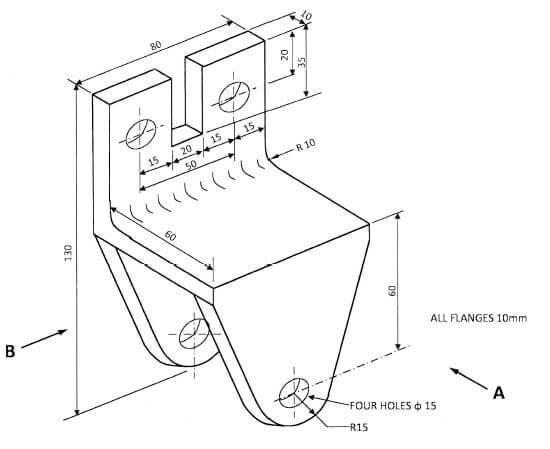
Draw FULL SIZE in Third Angle projection the following views (Use A3 paper provided):- front elevation in the direction of arrow A;
- end elevation in the direction of arrow B;
- plan.(14 marks)
-
- Explain four operational differences between Aeropiston and Aerojet engines.(4 marks)
- With the aid of a labelled sketch, show the cross-section of an aircraft propeller G governor.(10 marks)
-
- Outline three advantages of plastics over metals in aircraft construction.(3 marks)
- Explain five selection criteria for aircraft engine bolts.(5 marks)
- Outline the procedure of making a through M10 threads on a 10mm mild steel plate.(6 marks)
-
- Explain four functions of aircraft tabs during flight.(4 marks)
- With the aid of labelled sketches, describe the operation of each of the following aircraft tabs to effect pitching moments.
- Servo
- Trim(10 marks)
-
- Define each of the following terms as applied to Aviation industry,(2 marks)
- Indicated airspeed.
- Ground speed.
- Explain the function of each of the following aircraft electrical safety devices.(3 marks)
- Magnetic indicators.
- Circuit breakers.
- Weight switch.
- With the aid of a labelled sketch, explain the principle of electrical power generation of an aircraft.(9 marks)
- Define each of the following terms as applied to Aviation industry,(2 marks)
MARKING SCHEME
-
- Types of aircraft fires
- Class B fire involves inflammable fluids such as gasoline, kerosine oils etc. while
- Class C fire involves energized electrical equipment.(2 marks)
- Types of fire extinguishing agents
- Class C - carbon dioxide.
- Class D - dry powder. (2 marks)
- Types of aircraft fires
-
- Roles of aircraft dispatchers:
- Schedule flights.
- Ensure all civil aviation regulations are adhered to.
- Flight plans.
- Supply meteorological reports.
- Briefing the flight crew.(Any 3 x 1 = 3 marks)
- Roles of aircraft dispatchers:
- Meteorological measuring instruments.
- Hydrometer - for measuring humidity.
- Barometer - for measuring air pressure
- Windvane/Anemometer - for measuring speed and direction of wind.
- Thermometer - for measuring temperature.
- Rain gauge - for measuring the amount of rain.(Any 4 x 1 = 4 marks)
-
- Advantages of blind rivets.
- Long grip area/length.
- Easy to use.
- Easily accessible from one side.
- Less noisy.(Any 2 x 1 = 2 marks)
- Reasons for using structural screw.
- Made of alloy steel, properly heat treated, definite grip length, shear and tensile strength. (1 mark)
- Advantages of blind rivets.
-
- Types of drag.
Profile drag is the resistance encountered by virtual of forcing an abject viscous fluid tending to stick to the object owing to its shape, while induced drag is the resistance formed on the wing tips owing to vortices of bottom and top air flow. (2 marks) - Body shapes airflow patterns.
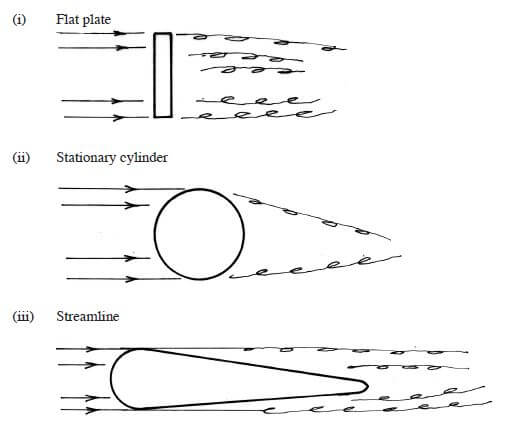
(3 x 1 = 3 marks) - Behaviour of "Boundary Layer"
- Boundary layer is a thin layer of air lying over the surface of the wing from zero to full velocity.
- Because air has viscosity this layer of air tends to adhere/stick to the wing.
- As the wing moves forward through the air; the boundary layer as first flows smoothly (lamina) over the stream line shape.
- As the boundary layer approaches the centre of the wing it begins to break away from the surface forming eddies to become turbulent at separation point.
- The layer in actual contact with the surface moves at zero velocity relative to the wing. (It moves at the same speed as the wing).(4 x 21 = 2 marks)
- Types of drag.
-
- Testing methods.
Non destructive testing is an adequate means of checking the serviceability of an aircraft part without causing any harm.
while
Destructive testing is a means of checking a specimen of an aircraft part on the assumption that the aircraft will behave in the same manner.
The specimen is destroyed.(2 marks) - Aircraft structure terms.
Fuselage - the main body of the aircraft which accommodates passengers, crew and cargo and the main attachment of other parts of the aircraft.
while
Cockpit is a compartment forming a part of the fuselage to accommodate the flight crew. (2 marks)
- Testing methods.
- Types of aeropiston oil systems.
"Wet sump"- Oil is stored beneath the crankshaft in the oil pan.
- Oil pump sucks oil from the bottom pan through a tube and the pumps to the rest of the engine.
- The pan has to be large enough to accommodate sufficient oil.
while
"Dry sump" - Extra oil is stored in a tank outside the engine rather than the oil pan.
- As at least a suction and a seavage pump.
- The maximum amount of oil remains in the engine.(6 x 1 = 6 marks)
-
- Aircraft instrument range colour markings.
- Red radical line - indicates maximum and minimum operating ranges.
- Blue arc - indicates that operation is permitted under certain conditions.
- Green arc - indicates the normal operating range.
- Yellow arc - indicates caution operating range.
- White arc - indicates the alignment of the glass and instruments.(Any 4 x 1 = 4 marks)
- Gyroscopic instruments:
- Artificial horizon.
- Heading indicator.
- Turn and slip indicator/turn and back indicator.(Any 2 x 21 = 1 mark)
- Aircraft instrument range colour markings.
-
- Fabrication tools.
- Bucking bar - a tool held against the shank end of a rivet while the snap head is being formed.
- Countersunk bit - a tool which cuts a cone shaped depression around a rivet hole to allow the rivet to set flush with the surface of the skin.(2 x 1 = 2 marks)
- Reasons for paint removal on aircraft parts.
- Deterioration of the paint.
- When corrosion is evident.
- Inspection purpose.
- Retention of original paint.
- To retain the original weight of aircraft.(Any 2 x 1 = 2 marks)
- Fabrication tools.
- Drawing symbols.
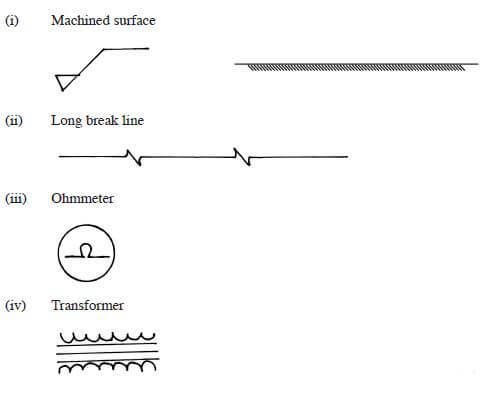
(4 x 1 = 4 marks) -
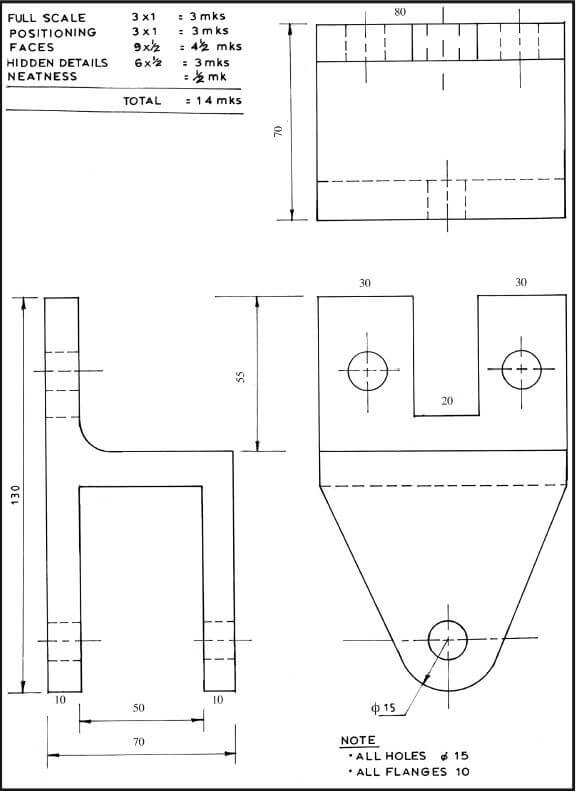
-
- Engine operational differences.
- Aeropiston engine uses gasoline as the fuel media while aerojet engine uses kerosine as fuel.
- In Aeropiston engine all the cycles occur in the same cylinder while in Aerojet engine cycles occur in different chambers.
- Ignition occur on every cycle on aeropiston engine while it only occurs during starting on aerojet engine.
- Aeropiston engine generates thrust with a propeller while aerojet engines generates thrust with jet efflux.
- Aeropiston engine operates at peak temperatures while the aerojet operates at constant temperatures.
- Aeropiston engine uses mineral oil while aerojet engine uses synthetic oil for lubrication.(Any 4 x 1 = 4 marks)
-
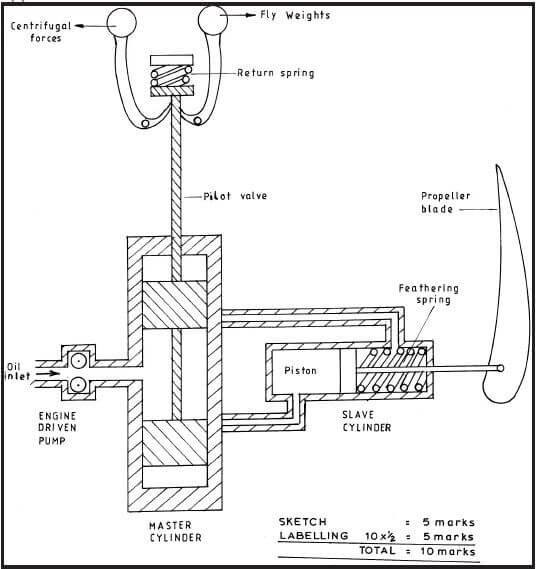
- Engine operational differences.
-
- Advantages of plastics over metals.
- High strength to weight ratio.
- Does not reflect sound and rays.
- Poor conductors of heat thus can be used as an insulators.
- Resistant to corrosion.
- Can be coloured for good interior decoration.
- Easily machined.
- Cheaper.
- Transparent.(Any 3 x 1 = 3 marks)
- Selection criteria for aircraft engine bolts.
- Length - this depends on the width of the pieces to be joined.
- Thread - the type of thread may be metric or British, coarse or fine.
- Material - depends on the material being joined to avoid reaction.
- Type of head - whether hexagonal, allen head or clevis head.
- Heat treatment - whether coated, hardened or annealed.
- Method of locking - seal, castrated, locking wire, split pin.(Any 5 x 1 = 5 marks)
- Making a M10 through thread on 10 mm mild steel.
- Mark out and centre punch the location of the hole.
- Drill with an appropriate drill bit.
- Holding the taper tap at right angles to the plate cut the threads clock wise for half a revolution and anti-clockwise for quarter of a revolution through the plate using appropriate lubrication.
- Repeat step (iii) using intermediate tap.
- Repeat step (iv) using plug tap.
- Debur and clean off the swarf.
- Test with M10 bolt for tolerance.(Any 6 x 1 = 6 marks)
- Advantages of plastics over metals.
-
- Function of aircraft tabs.
- Trimming purpose.
- Augment the force required by the pilot.
- Increase the effort required by the pilot.
- Fine correction of the selected primary controls position.
- To relief the pilot on repeatative manoeuvre.(4 x 1 = 4 marks)
- Types of tabs.
- Servo tab

This is the type of tab that is connected to the main control stick to raise or lower the aircraft nose.
When it is required say to lower the nose the control stick is pushed forward. Pushing the control stick raises the servo tabs.
Raising the servo tab increases the bottom camber of the elevator to lower the elevator. Lowering the elevator increases the top camber of the tail plance to generate lift and raise the empennage to rotate the aircraft about the lateral axis and lower the nose of the aircraft and vice versa.
Sketch 1 mark
Labelling 2 marks
Explanation 2 marks
TOTAL = 5 marks - Trim tab
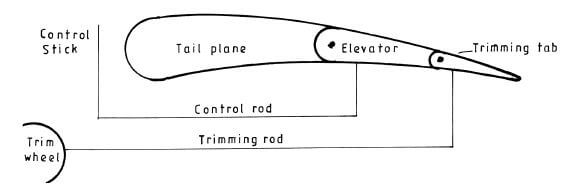
When required say to raise the nose of the aircraft the control stick is pulled backwards. Pulling the control stick lowers the trim tab.
Lowering the trim tab increases the top camber of the elevator to generate lift that raises the elevator.
Raising the elevator increases the bottom camber of the tail plane to generate lift at the bottom to pull the empennage downwards to rotate the aircraft about the lateral axis to raise the nose of the aircraft.
Sketch 1 mark
Labelling 2 marks
Explanation 2 marks
TOTal = 5 marks
(Total 14 b = 14 marks)
- Servo tab
- Function of aircraft tabs.
-
- Aircraft terms.
- Indicated airspeed - This is the rate at which the air particles move past an aerofoil of the aircraft wing in flight.
- Ground speed is the velocity with which the aeroplane moves over the earths surface.(2 marks)
- Aircraft electrical devices.
- Magnetic indicators - these are devices acting as feed back to practically confirm that the selected value has actually opened or closed on selection.
- Circuit breaker - these are devices used to isolate faulted circuits but can be manually reset when faults clears. They can also be tripped to simulate a condition on an aircraft system.
- Weight switch - this is a device that moves on ground to prevent some systems not to be operated when the aircraft is on ground.(3 marks)
- Electrical power generation.
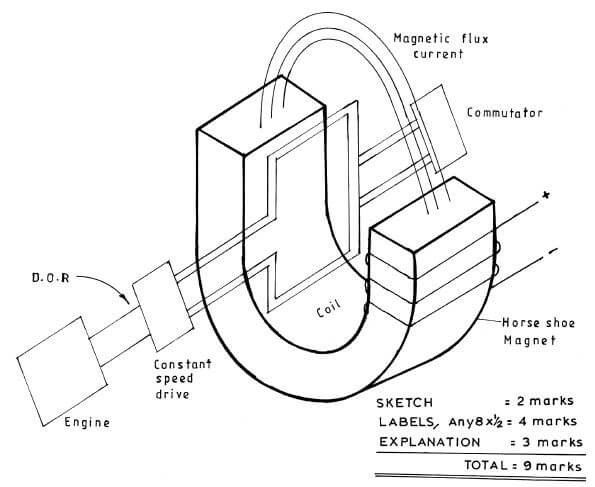
The aircraft engine rotates through a constant speed and drives a coil placed in a strong magnetic field.
Cutting magnetic lines of forces creates a magnetic electromotive force (EMF) that induces a potential difference to cause a current to flow. This current can be picked by commutators or brushes to be supplied to the aircraft.(9 marks)
- Aircraft terms.
Download KCSE 2014 Aviation Technology Paper 1 Questions with Marking Scheme.
Tap Here to Download for 50/-
Get on WhatsApp for 50/-
Why download?
- ✔ To read offline at any time.
- ✔ To Print at your convenience
- ✔ Share Easily with Friends / Students

